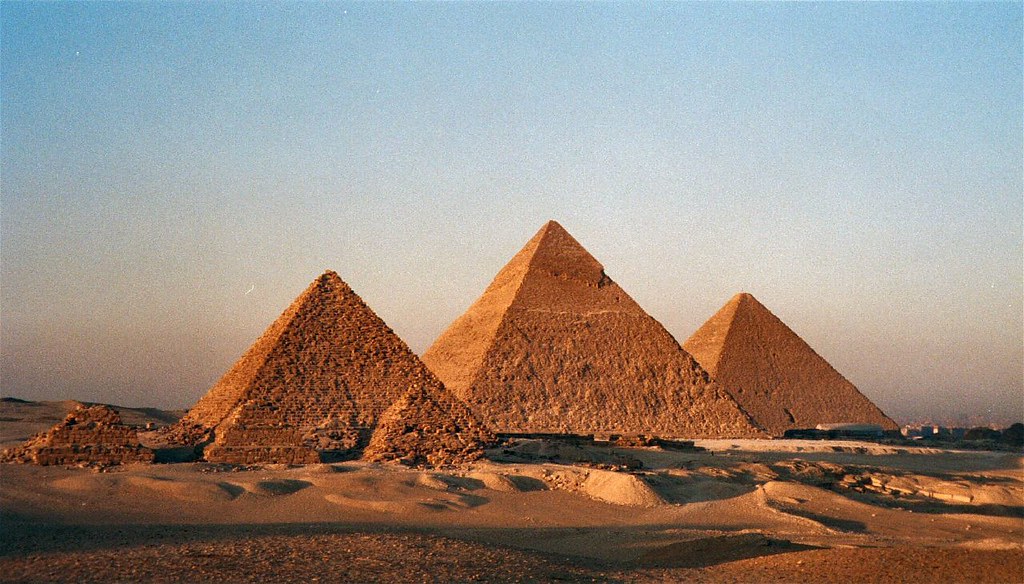The Great Pyramid of Giza, which rose from the Egyptian sands some 4,500 years ago, is a structure that not only defies time but also confounds contemporary theories. For more than 4,000 years, it was the tallest man-made structure, standing at 147 meters. The ancient Egyptians accomplished a feat that is still unparalleled in durability and mystery, even though they lacked cranes, wheels, and iron tools.
Constructed Without the Use of Contemporary Technology
The Great Pyramid was built with an estimated 6 million tonnes of granite and limestone, making it heavier than the Burj Khalifa, the tallest skyscraper in the world today, which only weighs 500,000 tonnes. Even after millennia of storms, sun, and sand, it remains intact.
This magnificent monument wasn’t by itself. Together with the Pyramid of Khafre and the Pyramid of Menkaure, it forms one of three structures that make up the famous Giza Plateau complex, which also contains the Great Sphinx and numerous smaller tombs and buildings.
Who Built It—and Why?
Around 2560 BCE, Pharaoh Khufu is thought to have ordered the construction of the pyramid. The duration of Khufu’s reign, which ranges from 23 to more than 60 years, is still up for debate, making him a shadowy figure. Khufu was the second ruler of Egypt’s Fourth Dynasty.
However, it is evident that the pyramids were constructed as tombs. The belief of the ancient Egyptians was that the soul would be judged in the afterlife. Pharaohs were buried with food, wealth, and items they could use after they died, and they were mummified.
It’s interesting to note that only an empty sarcophagus was discovered inside the Great Pyramid itself, along with no conclusive burial evidence. As a result, other theories have emerged, including:
- According to popular pseudoscience, the Pyramid was a power plant.
- Joseph constructed the granary, according to a theory put forth by politician Ben Carson.
Even though its contents were probably looted, archaeologists generally concur that it was a tomb.
Who Did the Heavy Lifting? Not Slaves
The pyramids were not constructed by slaves, despite what Hollywood portrays. According to archeological evidence, skilled workers who were well-fed and healthier than the typical Egyptians of their era resided close to the construction site. For 20 years, these workers organized into a workforce of roughly 20,000 to 30,000 individuals who worked shifts.
The Construction Mysteries
Building the Great Pyramid required:
- 5.5 million tonnes of limestone
- 8,000 tonnes of granite
- 500,000 tonnes of mortar
But how did they move these massive stones?
Tools and Techniques
- Copper tools were used to cut softer limestone.
- Dolerite stones were used to break harder granite.
- A clever method involved inserting wooden wedges into cracks, soaking them in water, and letting the expansion split the stone.
Transporting the Stones
Wheels weren’t in use yet. Stones were likely:
- Transported via rafts on the River Nile.
- Dragged on sledges across wet sand, a method supported by ancient paintings and modern physics experiments, which showed that a small amount of water (about 2-5%) reduced friction significantly.
Lifting the Stones
There are two main theories:
Ramps: Stones may have been pulled upward using long, straight ramps supported by wooden posts and ropes. This theory was supported in 2015 by the discovery of a 4,500-year-old ramp in a quarry.
Levers: It is thought that the Egyptians lifted stones with basic leverage by employing a counterweight mechanism akin to the Shadoof, an irrigation implement.
Despite these concepts, the math is overwhelming: one block had to be placed every three minutes, every day, to be completed in 20 years. For this reason, one of the biggest engineering mysteries in history is still the construction process.
Precision and Longevity
The Great Pyramid isn’t just massive—it’s astonishingly precise:
- Aligned almost perfectly to true North, with only a 1/15th of a degree error.
- The base layers used no mortar, relying on perfect stone fitting, while the upper layers used mortar that scientists still can’t replicate today.
The pyramid was originally white, with sun-reflecting casing stones made of fine Tura limestone. Although remnants of these can still be seen at the summit of the Pyramid of Khafre, the majority have been destroyed or eroded.
In conclusion, it’s still a mystery and a marvel.
There is more to the Great Pyramid of Giza than just an old tomb. It is a representation of human ingenuity, ambition, and eternal mystery. We still don’t have all the answers after centuries of research. Perhaps that’s part of what makes it so intriguing.







